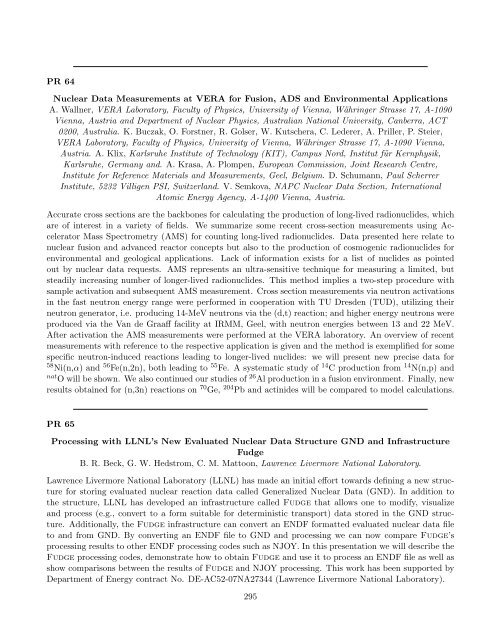Program - Brookhaven National Laboratory
Program - Brookhaven National Laboratory
Program - Brookhaven National Laboratory
Create successful ePaper yourself
Turn your PDF publications into a flip-book with our unique Google optimized e-Paper software.
PR 64<br />
Nuclear Data Measurements at VERA for Fusion, ADS and Environmental Applications<br />
A. Wallner, VERA <strong>Laboratory</strong>, Faculty of Physics, University of Vienna, Währinger Strasse 17, A-1090<br />
Vienna, Austria and Department of Nuclear Physics, Australian <strong>National</strong> University, Canberra, ACT<br />
0200, Australia. K. Buczak, O. Forstner, R. Golser, W. Kutschera, C. Lederer, A. Priller, P. Steier,<br />
VERA <strong>Laboratory</strong>, Faculty of Physics, University of Vienna, Währinger Strasse 17, A-1090 Vienna,<br />
Austria. A. Klix, Karlsruhe Institute of Technology (KIT), Campus Nord, Institut für Kernphysik,<br />
Karlsruhe, Germany and. A. Krasa, A. Plompen, European Commission, Joint Research Centre,<br />
Institute for Reference Materials and Measurements, Geel, Belgium. D. Schumann, Paul Scherrer<br />
Institute, 5232 Villigen PSI, Switzerland. V. Semkova, NAPC Nuclear Data Section, International<br />
Atomic Energy Agency, A-1400 Vienna, Austria.<br />
Accurate cross sections are the backbones for calculating the production of long-lived radionuclides, which<br />
are of interest in a variety of fields. We summarize some recent cross-section measurements using Accelerator<br />
Mass Spectrometry (AMS) for counting long-lived radionuclides. Data presented here relate to<br />
nuclear fusion and advanced reactor concepts but also to the production of cosmogenic radionuclides for<br />
environmental and geological applications. Lack of information exists for a list of nuclides as pointed<br />
out by nuclear data requests. AMS represents an ultra-sensitive technique for measuring a limited, but<br />
steadily increasing number of longer-lived radionuclides. This method implies a two-step procedure with<br />
sample activation and subsequent AMS measurement. Cross section measurements via neutron activations<br />
in the fast neutron energy range were performed in cooperation with TU Dresden (TUD), utilizing their<br />
neutron generator, i.e. producing 14-MeV neutrons via the (d,t) reaction; and higher energy neutrons were<br />
produced via the Van de Graaff facility at IRMM, Geel, with neutron energies between 13 and 22 MeV.<br />
After activation the AMS measurements were performed at the VERA laboratory. An overview of recent<br />
measurements with reference to the respective application is given and the method is exemplified for some<br />
specific neutron-induced reactions leading to longer-lived nuclides: we will present new precise data for<br />
58 Ni(n,α) and 56 Fe(n,2n), both leading to 55 Fe. A systematic study of 14 C production from 14 N(n,p) and<br />
nat O will be shown. We also continued our studies of 26 Al production in a fusion environment. Finally, new<br />
results obtained for (n,3n) reactions on 70 Ge, 204 Pb and actinides will be compared to model calculations.<br />
PR 65<br />
Processing with LLNL’s New Evaluated Nuclear Data Structure GND and Infrastructure<br />
Fudge<br />
B. R. Beck, G. W. Hedstrom, C. M. Mattoon, Lawrence Livermore <strong>National</strong> <strong>Laboratory</strong>.<br />
Lawrence Livermore <strong>National</strong> <strong>Laboratory</strong> (LLNL) has made an initial effort towards defining a new structure<br />
for storing evaluated nuclear reaction data called Generalized Nuclear Data (GND). In addition to<br />
the structure, LLNL has developed an infrastructure called Fudge that allows one to modify, visualize<br />
and process (e.g., convert to a form suitable for deterministic transport) data stored in the GND structure.<br />
Additionally, the Fudge infrastructure can convert an ENDF formatted evaluated nuclear data file<br />
to and from GND. By converting an ENDF file to GND and processing we can now compare Fudge’s<br />
processing results to other ENDF processing codes such as NJOY. In this presentation we will describe the<br />
Fudge processing codes, demonstrate how to obtain Fudge and use it to process an ENDF file as well as<br />
show comparisons between the results of Fudge and NJOY processing. This work has been supported by<br />
Department of Energy contract No. DE-AC52-07NA27344 (Lawrence Livermore <strong>National</strong> <strong>Laboratory</strong>).<br />
295
















